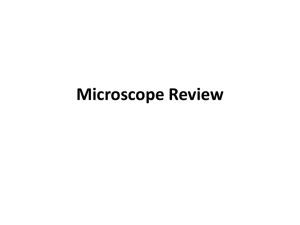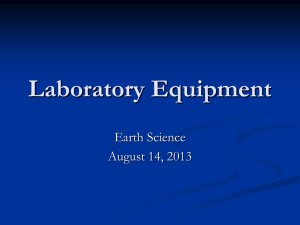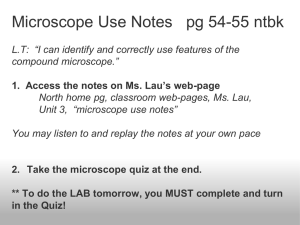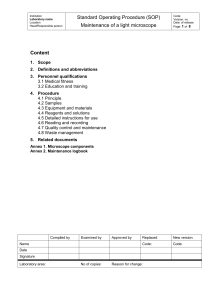Lab 1 – Microscope and Cells
advertisement
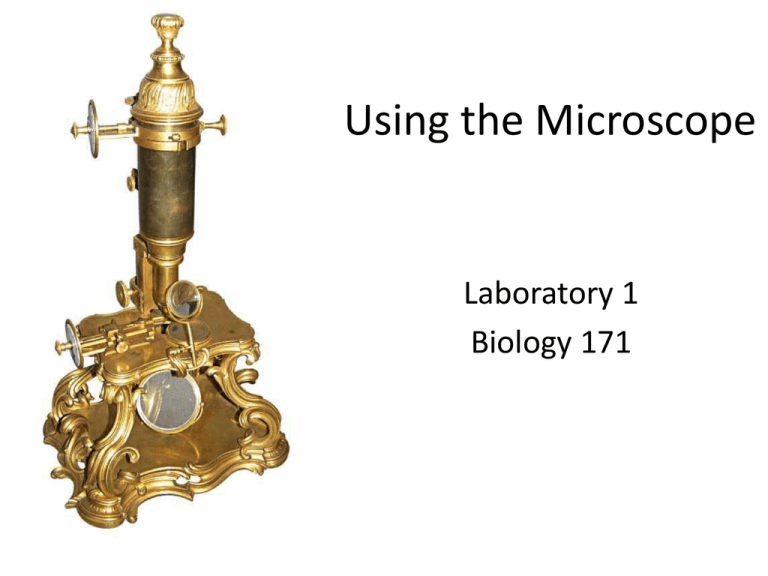
Using the Microscope Laboratory 1 Biology 171 Today in Lab Microscope Exercise 1: The Compound microscope - Parts of the Compound microscope Exercise 2: Technique - Field of view, depth of field, magnification Exercise 3: Using the microscope - prepping a wet mount slide, looking at Elodea Exercise 5: Cell organization and complex processes - Trichonympha, symbiosis - cell types (animal and plant) Bacteriology Culture microorganisms for Next Week… What did the invention of the microscope enable? • DUH…. to look at tiny stuff • Individual cells could be observed – Allowed scientists to see that all cells are very similar, but often take on different functions • Allowed us to see very small things – Typical cell = 0.02 mm – Our eyes can only see 0.2 mm • Invented around 1675; telescopes around 1605. • Fundamentally changed how we saw ourselves and nature. Dutch Inventor: Antoni van Leeuwennhoek Determining Total Magnification Multiply the magnification of each set of lenses: Total magnification = magnification of objective X magnification of eyepiece Scanning power: 10 4 eyepiece ______x times objective _____x Low power: eyepiece ______x times objective _____x High power: eyepiece ______x times objective _____x Oil immersion power: eyepiece ______x times objective _____x 40 = _____x = _____x = _____x = _____x Page 4, lab manual Parts of the Compound Microscope Note: know these parts for the quiz! Using the Microscope ATTENTION! Important to follow these steps: 1. Plug in and turn on the light source. Adjust light source as needed. 2. Clean the objective lens with lens paper and Windex 3. Move the stage to its lowest position. 4. Make sure the lowest objective is in place (4x). 5. Place the slide on the stage and secure it with the slide clips/holder. 6. Use the stage controls to center the slide over the light source. Look at the slide from the side of the microscope, not through the eyepieces. 7. Looking through the eyepieces, use the coarse adjustment knob to bring the slide toward the objective. Soon you will see the image come into view. 8. After you get the image as clear as possible with the coarse adjustment, use the fine adjustment knob to further focus the image. 9. You may now go to a higher objective if you want, but be sure to ONLY use the fine adjustment knob to focus. (Also, be sure you are going to the next highest objective and NOT the oil immersion). The microscope objectives should be parfocal, as an image is focused with one objective, it will also be in focus in the other objectives. Field of View We will be using a ruler to measure the field of view. What is the field of view in this image? 7 mm Micrometer The images we will be looking at under the microscope are often too small to be measured in millimeters. Thus, we use the micrometer… 1 mm = 1000 µm 1 µm = 0.001 mm 7 mm = ? µm Remember our conversions: 1 mm = 1000 µm 1 µm = 0.001 mm 1 µm = 1 x 10-3 mm 7 mm (1000 µm/1 mm) = 7000 µm 7 mm (1 x 10-3 µm/mm)= 7000 µm *Note: about 1/3 of previous students miss this question on the quiz. Depth of Focus Def: the thickness of the specimen that can be seen in focus at any time Preparing a Wet Mount Pro tip: Use a Kimwipe to absorb extra water. This will suck the cover slip down to the slide and prevent “wobble.” Quick note: Oil Immersion • PLEASE be very careful!! • 100 x objective ONLY Procedure: 1. After focusing in the high power objective, move the nosepiece half way between this and the oil immersion objective. 2. Place a small drop of oil on the coverslip. 3. Move the oil immersion objective into and through the oil and secure in position. 4. ONLY use the fine adjustment (and only a little bit) to focus Oil Immersion cont. • After you are finished, be sure to wipe the oil immersion lens with LENS paper and LENS CLEANER to remove the oil. ONLY use lens paper or else you will damage the objectives. • Seriously. Use lens paper, not Kimwipes. 3 domains of life Inside Eukarya - Most (but not all!) organisms are unicellular - If it’s not a plant, animal, or fungus, it’s called a protist - Protists are “paraphyletic” and make up the vast majority of eukaryotic diversity. Amoebas – page 15 Amoeba proteus Pseudopodia – temporary extensions of amoeboid cells, function in moving and engulfing food Phagocytosis – The act of engulfing food Where does this organism get its energy from? Physarum (plasmodial stage) Is slime mold smarter than Japan's railway engineers? check it out at home. It’s pretty neat. 1 point EC on the quiz next week possible. Slime Mold Life Cycle Trichonympha – pg 16 • Lives in the intestine of the termite • Bacterial endosymbionts inside Trichonympha digest cellulose - Termite > Trichonympha > Spirochetes Procedure 1. 2. 3. 4. 5. 6. Place a couple of drops of Ringer’s solution on a clean slide. Transfer a termite into the drop of solution. (Troika dolls) Place slide under a dissecting microscope. Place the tips of dissecting needles at either end of the termite and pull in opposite directions. Locate the long tube that is the termite’s intestine. Place a cover slip over the specimen and lightly press down on coverslip to release the Trichonympha from the intestines. Observe with a compound microscope. Can you see the spirochetes, too? If so, show me! A word on symbiosis… An interaction between organisms that is mutually beneficial. Protococcus & Scenedesmus, pg 17 (Do this part last, if you’ve got time). Plant Cells In addition to the nucleus, we will also be able to see the cell wall and chloroplasts. Elodea Leaf, pg 19 http://waynesword.palomar.edu/lmexer1.htm#elodea Elodea cytoplasmic streaming Moves nutrients, genetic info, raw material throughout the cell using actin proteins. Why does this happen? Animal Cells Most structures in animals cells are too small to see. We will be able to see the plasma membrane and the nucleus today. Cheek Cells, pg 20 • Stained with methylene blue • Only attaches to DNA, so only see nucleus • Fun fact: methylene blue may be a treatment for malaria, cancer, alzheimer’s and cyanide poisoning. http://waynesword.palomar.edu/lmexer1.htm#cheek Culturing Microorganisms, pg. 45 Purpose: We will be sampling microorganisms in from our environment and observing the effectiveness of antimicrobial agents. – Be creative! – The UC! Outside! Between your toes! – Find a unique area to sample – Or a few groups could sample the same surface and test the effectiveness of different antimicrobial agents Work in pairs (not enough agar plates) (Note: we may not do this portion of the lab) Using Antimicrobial Agents • Divide your plate in half – put an antimicrobial agent on half of the plate – Examples: listerine, vinegar, pine sol, mikroquat disinfectant • Only need a little bit so it doesn’t diffuse over to other half of plate • Write on the BOTTOM of the plate (not on lid) and indicate what half has the antimicrobial agent What to include on BOTTOM of plate Antimicrobial agent Names Lab Section Surface Sampled Date NO antimicrobial agent Culturing Microorganisms Procedure: 1. Wet a cotton swab with sterile water and swab the environmental surface 2. Inoculate an agar plate on both halves of the plate – do the side WITHOUT the antimicrobial agent FIRST 3. After innoculation… • Put the lid on the petri dish • Flip the whole dish upside down • Make sure your name and lab section (day) are on the bottom • Make a pile on the front desk REMINDERS: • Work productively and efficiently • Think creatively, critically, and freely. ASK QUESTIONS! • Take thorough notes, draw pictures, answer all questions in your lab notebook, and come up a QHM based on microorganisms or something you saw today. • Before you leave, make sure the lab is in the same condition as you found it. • Don’t forget! QHM – Question, Hypothesis, Methods • Also: be sure you know how to access the website, and have spoken with me personally if you are concerned about your writing ability and the research paper.





